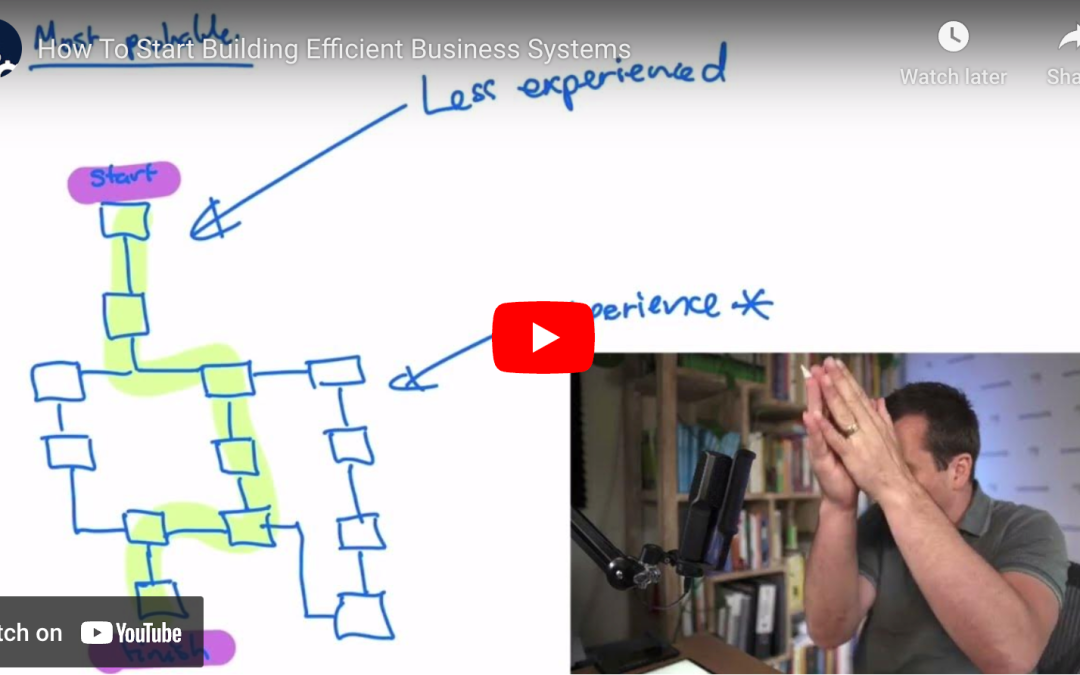Do you make this excuse when creating systems? “I can’t systemise this task because there are so many variations and options.”
It’s a common thought that stops people dead in their tracks.
For example, you might sell a product or service with various pricing options, and/or offer optional add-ons, and some of the steps end up being different because of the variations in your offerings.
So, how do you cater for these different options? Do you need to document every variation? How do you handle different team member skill levels and experience?
The answer is more simple than you realise.
When designing a system for the first time, you need to think about the most probable. In other words, what’s the most likely path in the customer journey? Consider the steps in that journey, then capture and optimise for that experience.
You’ll have team members with different levels of experience, and the more experienced staff that can handle those lesser-known cases.
So your front line will have your less experienced team members handle the most probable scenarios. Then when it heads off the beaten track, they can flag it for a more experienced team member to take over.
Now you can continue to build out your systems with the least disruption to your business because the skills and experience in your team are utilised optimally.
Check out this video below to learn more about how to optimise by capturing the most probable.
Timestamps:
0:13 – The different variables or scenarios that cause different results
0:34 – What to capture when designing a system for the first time
0:47 – The multiple paths that can deliver the outcome
1:44 – Think about capturing the most likely path
2:23 – How to factor in team members with different experience levels.
3:11 – Supporting the most probable path for the less experienced worker
3:36 – How to handle different variations over time
4:40 – Grab your copy of SYSTEMology
Transcription:
Hey, it’s David Jenyns, founder of SYSTEMology. In this video, we’re going to be talking about when you build systems, the idea of starting with first, capturing the most probable. As you start to build systems in your business and mapping out different processes, you will find quite often there might be different variables and scenarios that might cause different results.
So maybe when you’re selling something, there’s option A, B, or C. And depending on what the client ends up taking, some of the steps end up being a little bit different. So we need to think about, look, if we’re designing a system for the first time, do we capture all of those variations?
I’ve got a little graphic that kind of illustrates this quite well. If this is the start and this is the finish, you can see with this graphic, there might be multiple different paths that can happen to deliver. Maybe that product or service or that particular widget or whatever it is that you’re working on.
So these multiple paths, then the question becomes “If I’m creating a system, am I going to capture every variable?” Now, this is quite a simple example, and it might be easy to break away, but oftentimes there might be loads of different decisions that need to be made throughout the delivery of whatever the system is that you’re trying to capture. And the question is, are we going to capture all of those variables?
It can be quite overwhelming at the start to think about the immenseness of what might need to be captured to capture every possible scenario. So what I’m going to suggest is when you first build a system, capture what we call the most probable, what is the most likely path? Think about who is your ideal client and what is the system that you’re working on and what is most likely to happen and capture that experience. Optimise that experience.
Now, most likely you are going to be hiring great staff and that’s going to be part of your recruitment system that you’re building out a great team and you’re going to have team members with different levels of experience. You’re going to have team members that are newer to the team, and then you’re going to have team members that are more experienced.
Now, in situations where the path doesn’t follow the most probable and it goes off the beaten track, that’s where there may be these exceptions because you might not have it documented just yet. These scenarios go to your more experienced team members and all of the most probable paths, which is obviously the green one, maybe that goes to the less experienced team members.
Now, when you think about it, you’re designing a system and a process to capture the most probable. Then you’re getting less experienced team members to learn and follow that process and learn it inside and out. You’ve created systems processes extra videos supporting notes to all support that most probable path which then makes it easier for the less experienced team member to understand what to do as they move someone through that process and then when it heads off the beaten track then they can flag it for a more experienced team member to take over and then handle that exception.
Now over time your systems because they’re an organic document and they’re going to grow and evolve. You might add in different parts to the system that handle the different variations or you might create a separate process for when the client does this.
Now we look to do this but that comes down the line. Systems are organic documents that will continue to grow and evolve but in the early days when you’re just getting started just capture the most probable you will actually find that has tremendous wins for your business and also gets you focused on optimising for the most probable experience and scenario which is particularly important if you’ve selected a primary target audience or a client that you’re looking to serve and then you’re optimising towards them. That means that dream client is going to get the best experience because you’ve done the most thought and it will be that most probable path.
There are some ideas to explore if you want to find out more and you haven’t got a copy of the SYSTEMology book, definitely check that out. I think that’s going to be really helpful for you and I’ll see you in the next video.









